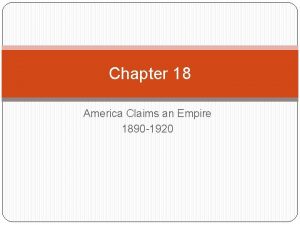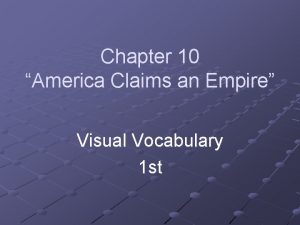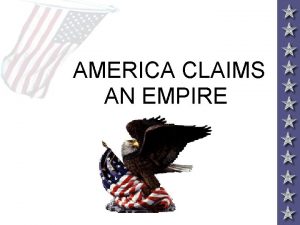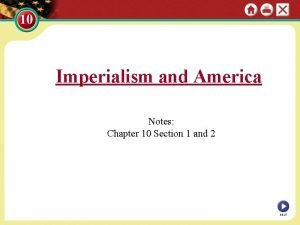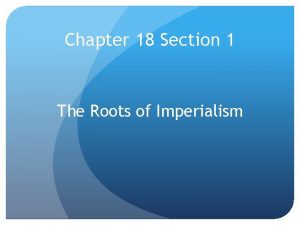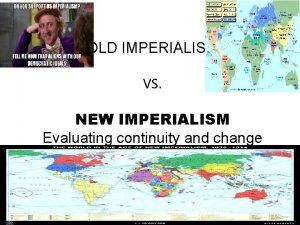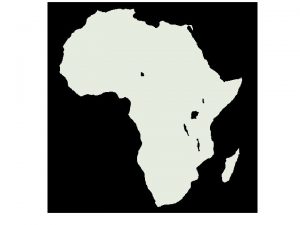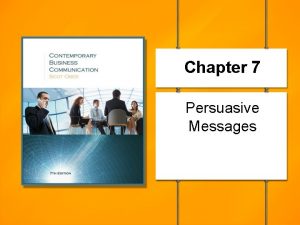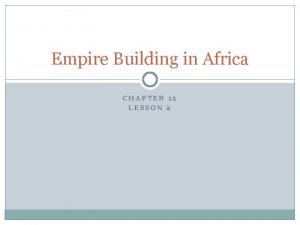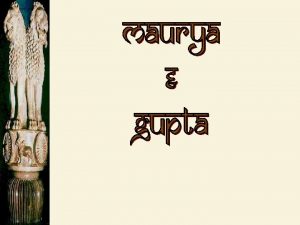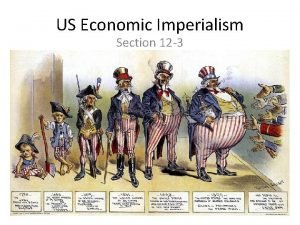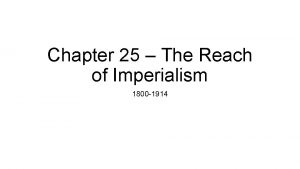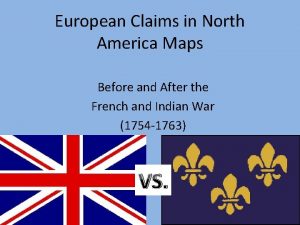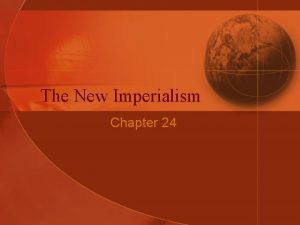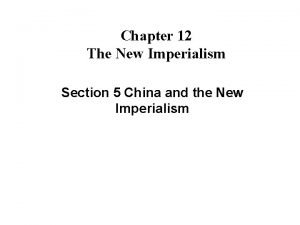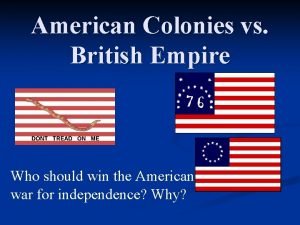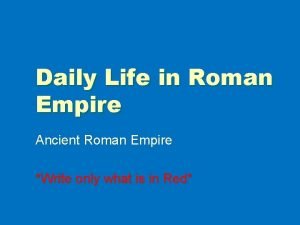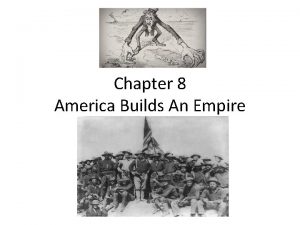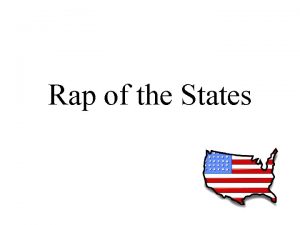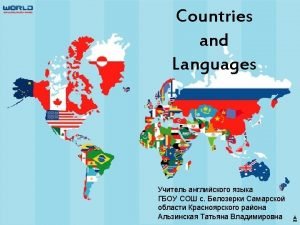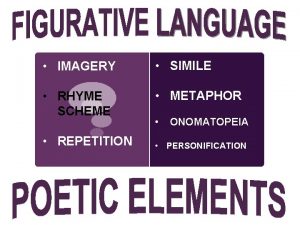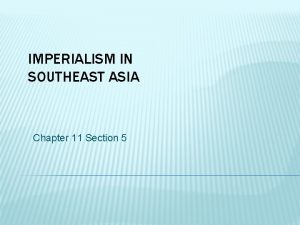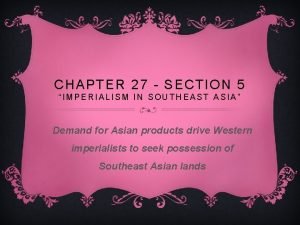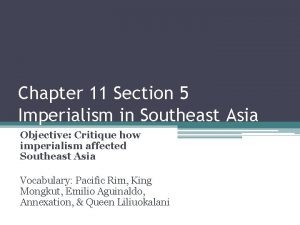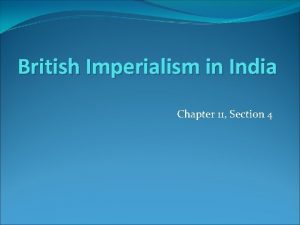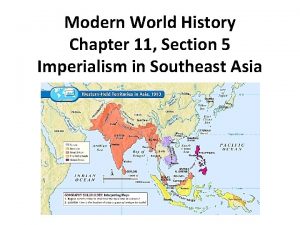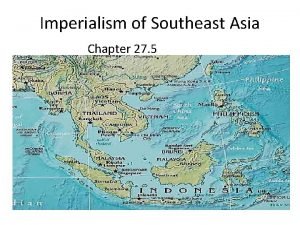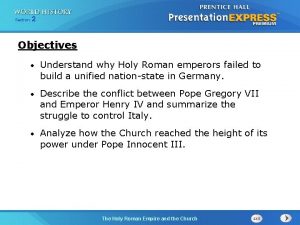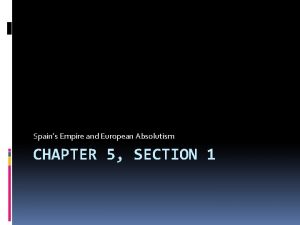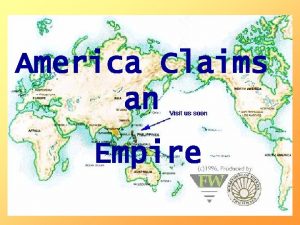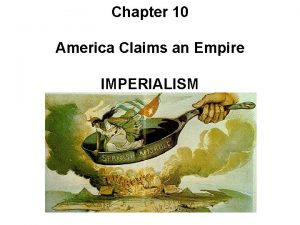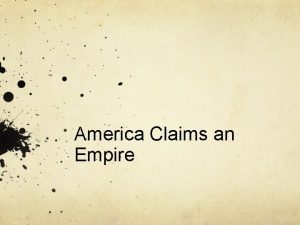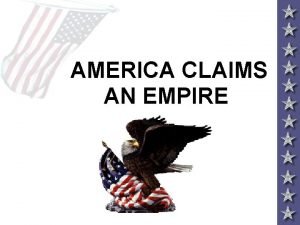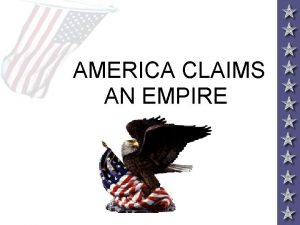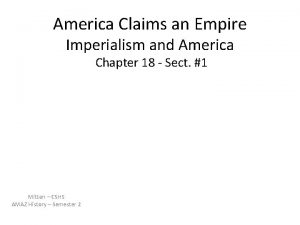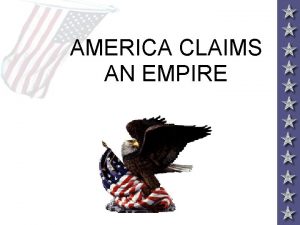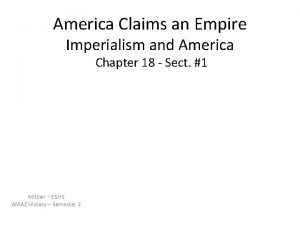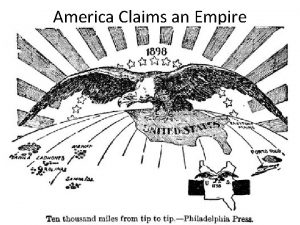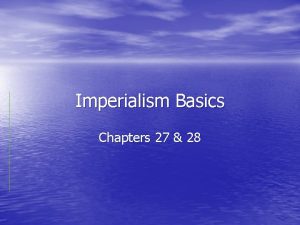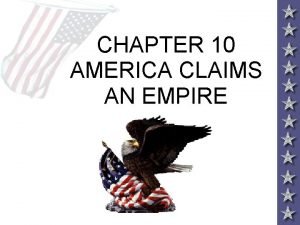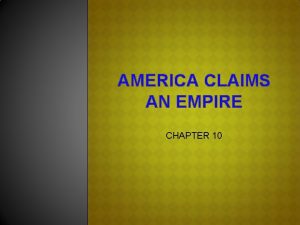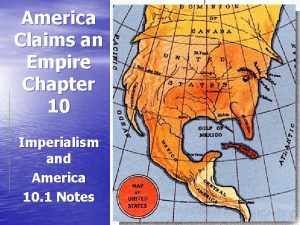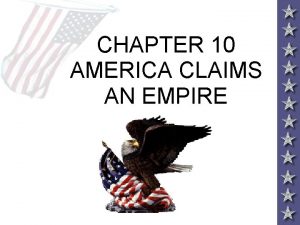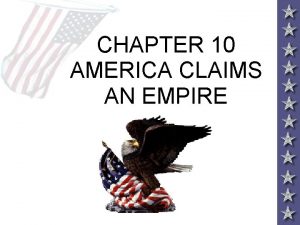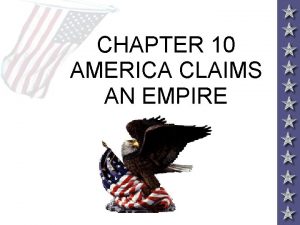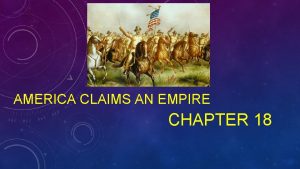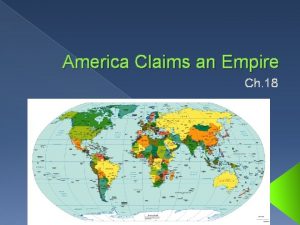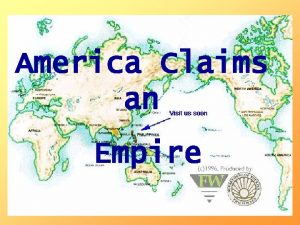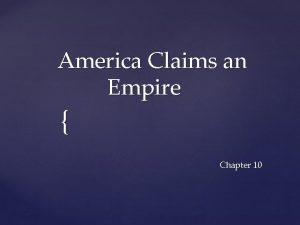America Claims an Empire SECTION 1 Imperialism and

































- Slides: 33

America Claims an Empire SECTION 1 Imperialism and America SECTION 2 The Spanish-American War SECTION 3 Acquiring New Lands SECTION 4 America as a World Power NEXT

Section 1 Imperialism and America Beginning in 1867 and continuing through the century, global competition causes the United States to expand. NEXT

SECTION I. Imperialism and America A. American Expansionism 1. . Global Competition • Imperialism—policy of extending control over weaker nations • In 1800 s, Europeans divide up most of Africa, compete for China • Japan joins race for China; U. S. decides to expand overseas 2. Desire for Military Strength • Admiral Alfred T. Mahan urges U. S. to build up navy to compete • U. S. builds modern battleships, becomes third largest naval power Continued. . . NEXT

SECTION 1 continued American Expansionism 3. Thirst for New Markets • U. S. farms, factories produce more than Americans can consume • U. S. needs raw materials, new markets for goods • Foreign trade: solution to overproduction, unemployment, depression 4. Belief in Cultural Superiority • Some combine Social Darwinism, belief in superiority of Anglo-Saxons • Argue U. S. has duty to Christianize, civilize “inferior peoples” NEXT

SECTION 1 B. The United States Acquires Alaska Early Expansion • William Seward—Secretary of State under Lincoln, Johnson • 1867, arranges purchase of Alaska from Russia for $7. 2 million - has trouble convincing House to fund purchase - Alaska called “Seward’s Folly” • Alaska rich in timber, minerals, oil NEXT

SECTION 1 C. The United States Takes Hawaii 1. The Cry for Annexation • Since 1790 s, U. S. merchants stop in Hawaii on way to China, India • Mid-1800 s, American-owned sugar plantations 75% of islands’ wealth • 1887, U. S. pressures Hawaii to allow naval base at Pearl Harbor - becomes refueling station • 1890 Mc. Kinley Tariff eliminates duty-free status of Hawaiian sugar • Planters call for U. S. to annex islands so will not have to pay duty Continued. . . NEXT

SECTION 1 continued The United States Takes Hawaii 2. The End of a Monarchy • 1887, businessmen force King Kalakaua to limit vote to landowners • Queen Liliuokalani tries to remove landowning requirement • With help of marines, business groups overthrow queen • Set up government headed by Sanford B. Dole • Under President Mc. Kinley, Congress proclaims Hawaii U. S. territory NEXT

Section 2 The Spanish-American War In 1898, the United States goes to war to help Cuba win its independence from Spain. NEXT

SECTION II. The Spanish-American War A. Cubans Rebel Against Spain 1. American Interest in Cuba • U. S. long interested in Cuba; wants to buy Cuba from Spain • During 1868– 1878 war for independence, American sympathies with Cuba 2. The Second War for Independence • José Martí—poet, journalist—launches second revolution in 1895 • Guerrilla campaign destroys American-owned sugar mills, plantations • U. S. public opinion split: - business wants to support Spain - others favor Cuban cause NEXT

SECTION 2 B. War Fever Escalates 1. Spain Takes Action • 1896, General Valeriano Weyler sent to Cuba to restore order • Puts about 300, 000 Cubans in concentration camps 2. Headline Wars • Newspapers exploit Weyler’s actions in circulation war • Yellow journalism—sensational writing used to lure, enrage readers Continued. . . NEXT

SECTION 2 continued War Fever Escalates 3. The de Lôme Letter • Mc. Kinley wants to avoid war, tries diplomacy to resolve crisis • Private letter by Spanish minister Enrique Dupuy de Lôme published - calls Mc. Kinley weak, swayed by public • Spain apologizes, de Lôme resigns; American public angry 4. The U. S. S. Maine Explodes • U. S. S. Maine sent to pick up U. S. citizens, protect U. S. property • Ship blows up in Havana harbor; newspapers blame Spain NEXT

SECTION 2 C. War with Spain Erupts 1. The U. S. Declares War • Spain agrees to most U. S. demands, public opinion still favors war • U. S. declares war April 1898 2. The War in the Philippines • First battle with Spain occurs in Spanish colony of the Philippines • Commodore George Dewey destroys Spanish fleet in Manila harbor • Filipinos, led by Emilio Aguinaldo, support Dewey • August 1898, Spanish troops in Manila surrender to U. S. Continued. . . NEXT

SECTION 2 continued War with Spain Erupts 3. The War in the Caribbean • U. S. blockades Cuba • Unlike navy, U. S. army has small professional force, many volunteers - volunteers ill-prepared, ill-supplied 4. Rough Riders • Rough Riders—Theodore Roosevelt leads volunteer cavalry • Roosevelt declared hero of attack on strategic San Juan Hill • Spanish fleet tries to escape blockade, is destroyed in naval battle • U. S. troops invade Puerto Rico soon after Continued. . . NEXT

SECTION 2 continued War with Spain Erupts 5. Treaty of Paris • Spain, U. S. sign armistice August 1898; meet in Paris to make treaty • Spain frees Cuba; hands Guam, Puerto Rico to U. S. ; sells Philippines 6. Debate over the Treaty • Treaty of Paris touches off great debate over imperialism • Mc. Kinley tries to justify annexation of Philippines on moral grounds • Opponents give political, moral, economic arguments against NEXT

Section 3 Acquiring New Lands In the early 1900 s, the United States engages in conflicts in Puerto Rico, Cuba, and the Philippines. NEXT

SECTION III. Acquiring New Lands A. Ruling Puerto Rico 1. Military Rule • Puerto Rico under military control • People split on independence, statehood, self-government under U. S. 2. Return to Civil Government • PR strategic as post in Caribbean, for protection of future canal • 1900, Foraker Act sets up civil government - president appoints governor, upper house • 1917, Puerto Ricans made U. S. citizens; elect both houses NEXT

SECTION 3 B. Cuba and the United States 1. American Soldiers • U. S. recognizes Cuban independence from Spain • Teller Amendment says U. S. has no intention of taking over Cuba • After war U. S. occupies Cuba; has same officials in office as Spain - Cuban protestors imprisoned or exiled • American military government helps rebuild the country Continued. . . NEXT

SECTION 3 continued Cuba and the United States 2. Platt Amendment • U. S. makes Cuba add Platt Amendment to its 1901 constitution • Platt Amendment does not allow Cuba to go into debt; also stipulates - no treaties that let foreign power control land - U. S. has right to intervene - U. S. can buy, lease land for navy • Protectorate—country whose affairs partly controlled by stronger one Continued. . . NEXT

SECTION 3 continued Cuba and the United States 3. Protecting American Business Interests • U. S. wants strong political presence to protect American businesses • Some object to colonial entanglements, do not think colonies needed NEXT

SECTION 3 Filipinos Rebel Philippine-American War • Filipinos outraged at Treaty of Paris call for annexation • 1899, Emilio Aguinaldo leads fight for independence against U. S. • U. S. forces Filipinos to live in designated zones in poor conditions - white U. S. soldiers see Filipinos as inferior - black troops troubled at spreading prejudice • 20, 000 Filipinos die in bloody fight for independence Aftermath of the War • U. S. president appoints governor who appoints upper house - people elect lower house • July 4, 1946, Philippines become independent NEXT

SECTION 3 C. Foreign Influence in China 1. U. S. Interest in China • U. S. sees China as vast potential market, investment opportunity • France, Britain, Japan, Russia have settlements, spheres of influence 2. John Hay’s Open Door Notes • U. S. Secretary of State John Hay issues Open Door notes • Notes ask imperialist nations to share trading rights with U. S. • Other powers reluctantly agree Continued. . . NEXT

SECTION 3 continued Foreign Influence in China 3. The Boxer Rebellion in China • Europeans dominate most large Chinese cities • Chinese form secret societies, including Boxers, to expel foreigners • U. S. , Britain, France, Germany, Japan put down Boxer Rebellion 4. Protecting American Rights • Hay issues new Open Door notes saying U. S. will keep trade open • Open Door policy reflects beliefs about U. S. economy: - growth depends on exports - U. S. has right to keep markets open - closing of area threatens U. S. survival NEXT

SECTION 3 D. The Impact of U. S. Territorial Gains 1. The Anti-Imperialist League • Mc. Kinley’s reelection confirms most Americans favor imperialism • Anti-Imperialist League has prominent people from different fields (Mark Twain) • For various reasons, agree wrong to rule others without their consent 2. There is no 2 NEXT

Section 4 America as a World Power The Russo-Japanese War, the Panama Canal, and the Mexican Revolution add to America’s military and economic power. NEXT

SECTION IV. America as a World Power A. Teddy Roosevelt and the World 1. Roosevelt the Peacemaker • Roosevelt does not want Europeans to control world economy, politics • 1904, Japan, Russia dispute control of Korea • Roosevelt negotiates Treaty of Portsmouth: - Japan gets Manchuria, Korea - Roosevelt wins Nobel Peace Prize Continued. . . NEXT

SECTION 4 continued Teddy Roosevelt and the World 2. Panama Canal • U. S. wants canal to cut travel time of commercial, military ships • U. S. buys French company’s route through Panama • Negotiates with Colombia to build Panama Canal; talks break down • French company agent helps organize Panamanian rebellion - U. S. gives military aid • U. S. , Panama sign treaty; U. S. pays $10 million for Canal Zone Continued. . . NEXT

SECTION 4 continued Teddy Roosevelt and the World 3. Constructing the Canal • Construction of canal is one of world’s greatest engineering feats - fight diseases, geographic obstacles - at height, 43, 400 workers employed Continued. . . NEXT

SECTION 4 continued Teddy Roosevelt and the World 4. The Roosevelt Corollary • Roosevelt fears European intervention if Latin America defaults • Reminds Europeans of Monroe Doctrine, demands they stay out • Roosevelt Corollary—U. S. to use force to protect economic interests 5. Dollar Diplomacy • Early 1900 s, U. S. exercises police power on several occasions • Dollar diplomacy—U. S. guarantees foreign loans by U. S. business NEXT

SECTION 4 B. Woodrow Wilson’s Missionary Diplomacy 1. The Mexican Revolution • Missionary diplomacy—U. S. has moral responsibility: - will not recognize regimes that are oppressive, undemocratic • Under dictator Porfirio Díaz, much U. S. investment in Mexico • 1911, peasants, workers led by Francisco Madero overthrow Díaz • General Huerta takes over government; Madero is murdered • Wilson refuses to recognize Huerta’s government Continued. . . NEXT

SECTION 4 continued Woodrow Wilson’s Missionary Diplomacy 2. Intervention in Mexico • Huerta’s officers arrest U. S. sailors, quickly release them • Wilson orders Marines to occupy Veracruz • Huerta regime falls; nationalist Venustiano Carranza new president 3. Rebellion in Mexico • Francisco “Pancho” Villa opposes Carranza - Villa a fierce nationalist • Wilson recognizes Carranza’s government; Villa threatens reprisals - Villa’s men kill Americans Continued. . . NEXT

SECTION 4 continued Woodrow Wilson’s Missionary Diplomacy 4. Chasing Villa • Brig. Gen. John J. Pershing leads force to capture Villa • Carranza demands withdrawal of U. S. troops; Wilson at first refuses • U. S. faces war in Europe, wants peace on southern border - Wilson orders Pershing home • Mexico adopts new constitution: • 1920, Alvaro Obregón new president; ends civil war, starts reforms NEXT

This is the end of the chapter presentation of lecture notes. Click the HOME or EXIT button.

Print Slide Show 1. On the File menu, select Print 2. In the pop-up menu, select Microsoft Power. Point If the dialog box does not include this pop-up, continue to step 4 3. In the Print what box, choose the presentation format you want to print: slides, notes, handouts, or outline 4. Click the Print button to print the Power. Point presentation BACK
 Chapter 18 america claims an empire
Chapter 18 america claims an empire Chapter 10 america claims an empire vocabulary
Chapter 10 america claims an empire vocabulary Chapter 18 building vocabulary america claims an empire
Chapter 18 building vocabulary america claims an empire Chapter 10 america claims an empire vocabulary
Chapter 10 america claims an empire vocabulary The americans chapter 18
The americans chapter 18 Chapter 10 section 1 imperialism and america
Chapter 10 section 1 imperialism and america Roots of imperialism
Roots of imperialism Old imperialism examples
Old imperialism examples Causes of new imperialism
Causes of new imperialism Unlike routine claims, persuasive claims:
Unlike routine claims, persuasive claims: Empire building in africa lesson 2
Empire building in africa lesson 2 Venn diagram of mauryan and gupta empires
Venn diagram of mauryan and gupta empires Economic imperialism definition
Economic imperialism definition Chapter 25 lesson 2 empire building in africa
Chapter 25 lesson 2 empire building in africa European claims in north america map
European claims in north america map Chapter 24 section 5 china and the new imperialism
Chapter 24 section 5 china and the new imperialism Chapter 12 section 5 china and the new imperialism
Chapter 12 section 5 china and the new imperialism American empire vs british empire
American empire vs british empire Rich and poor romans
Rich and poor romans Chapter 8 american imperialism
Chapter 8 american imperialism America america you mean the world to me
America america you mean the world to me America vs africa
America vs africa Repetition in let america be america again
Repetition in let america be america again Why called latin america
Why called latin america Performance e body art
Performance e body art Chapter 11 section 5 imperialism in southeast asia
Chapter 11 section 5 imperialism in southeast asia Imperialism in southeast asia chapter 27 section 5
Imperialism in southeast asia chapter 27 section 5 Chapter 11 section 5 imperialism in southeast asia
Chapter 11 section 5 imperialism in southeast asia British imperialism in india chapter 11 section 4
British imperialism in india chapter 11 section 4 Chapter 11 section 5 imperialism in southeast asia
Chapter 11 section 5 imperialism in southeast asia Imperialism in southeast asia chapter 27 section 5
Imperialism in southeast asia chapter 27 section 5 The holy roman empire and the church section 2
The holy roman empire and the church section 2 The holy roman empire and the church section 2
The holy roman empire and the church section 2 Chapter 5 section 1 spain's empire and european absolutism
Chapter 5 section 1 spain's empire and european absolutism
